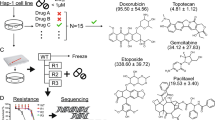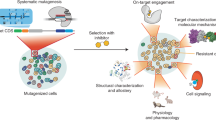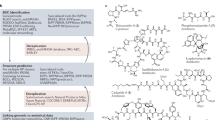Abstract
Natural variation in human drug metabolism and target genes can cause pharmacogenetic or interindividual variation in drug sensitivity1,2. We reasoned that natural pharmacogenetic variation in model organisms could be systematically exploited to facilitate the characterization of new small molecules. To test this, we subjected multiple Arabidopsis thaliana accessions to chemical genetic screens and discovered 12 accession-selective hit molecules. As a model for understanding this variation, we characterized natural resistance to hypostatin, a new inhibitor of cell expansion. Map-based cloning identified HYR1, a UDP glycosyltransferase (UGT), as causative for hypostatin resistance. Multiple lines of evidence demonstrate that HYR1 glucosylates hypostatin in vivo to form a bioactive glucoside. Additionally, we delineated a HYR1 substrate motif and used it to identify another molecule modulated by glucosylation. Our results demonstrate that natural variation can be exploited to inform the biology of new small molecules, and that UGT sequence variation affects xenobiotic sensitivity across biological kingdoms.
This is a preview of subscription content, access via your institution
Access options
Subscribe to this journal
Receive 12 print issues and online access
$259.00 per year
only $21.58 per issue
Buy this article
- Purchase on SpringerLink
- Instant access to full article PDF
Prices may be subject to local taxes which are calculated during checkout





Similar content being viewed by others
References
Evans, W.E. & McLeod, H.L. Pharmacogenomics–drug disposition, drug targets, and side effects. N. Engl. J. Med. 348, 538–549 (2003).
Roses, A.D. Pharmacogenetics and the practice of medicine. Nature 405, 857–865 (2000).
Arabidopsis Genome Initiative. Analysis of the genome sequence of the flowering plant Arabidopsis thaliana. Nature 408, 796–815 (2000).
Alonso-Blanco, C. & Koornneef, M. Naturally occurring variation in Arabidopsis: an underexploited resource for plant genetics. Trends Plant Sci. 5, 22–29 (2000).
Koornneef, M., Alonso-Blanco, C. & Vreugdenhil, D. Naturally occurring genetic variation in Arabidopsis thaliana. Annu. Rev. Plant Biol. 55, 141–172 (2004).
Bergelson, J., Stahl, E., Dudek, S. & Kreitman, M. Genetic variation within and among populations of Arabidopsis thaliana. Genetics 148, 1311–1323 (1998).
Nordborg, M. et al. The pattern of polymorphism in Arabidopsis thaliana. PLoS Biol. 3, e196 (2005).
Schmid, K.J., Ramos-Onsins, S., Ringys-Beckstein, H., Weisshaar, B. & Mitchell-Olds, T. A multilocus sequence survey in Arabidopsis thaliana reveals a genome-wide departure from a neutral model of DNA sequence polymorphism. Genetics 169, 1601–1615 (2005).
Mitchell-Olds, T. & Schmitt, J. Genetic mechanisms and evolutionary significance of natural variation in Arabidopsis. Nature 441, 947–952 (2006).
Weigel, D. & Nordborg, M. Natural variation in Arabidopsis. How do we find the causal genes? Plant Physiol. 138, 567–568 (2005).
Cutler, S. & McCourt, P. Dude, where's my phenotype? Dealing with redundancy in signaling networks. Plant Physiol. 138, 558–559 (2005).
Coutinho, P.M., Deleury, E., Davies, G.J. & Henrissat, B. An evolving hierarchical family classification for glycosyltransferases. J. Mol. Biol. 328, 307–317 (2003).
Guillemette, C. Pharmacogenomics of human UDP-glucuronosyltransferase enzymes. Pharmacogenomics J. 3, 136–158 (2003).
Bowles, D., Lim, E.K., Poppenberger, B. & Vaistij, F.E. Glycosyltransferases of lipophilic small molecules. Annu. Rev. Plant Biol. 57, 567–597 (2006).
Lim, E.K. et al. The activity of Arabidopsis glycosyltransferases toward salicylic acid, 4-hydroxybenzoic acid, and other benzoates. J. Biol. Chem. 277, 586–592 (2002).
Priest, D.M. et al. Use of the glucosyltransferase UGT71B6 to disturb abscisic acid homeostasis in Arabidopsis thaliana. Plant J. 46, 492–502 (2006).
Brazier-Hicks, M. & Edwards, R. Functional importance of the family 1 glucosyltransferase UGT72B1 in the metabolism of xenobiotics in Arabidopsis thaliana. Plant J. 42, 556–566 (2005).
Kroemer, H.K. & Klotz, U. Glucuronidation of drugs. A re-evaluation of the pharmacological significance of the conjugates and modulating factors. Clin. Pharmacokinet. 23, 292–310 (1992).
Mulder, G.J. Pharmacological effects of drug conjugates: is morphine 6-glucuronide an exception? Trends Pharmacol. Sci. 13, 302–304 (1992).
Teutonico, R.A., Dudley, M.W., Orr, J.D., Lynn, D.G. & Binns, A.N. Activity and accumulation of cell division-promoting phenolics in tobacco tissue cultures. Plant Physiol. 97, 288–297 (1991).
Shao, H. et al. Crystal structures of a multifunctional triterpene/flavonoid glycosyltransferase from Medicago truncatula. Plant Cell 17, 3141–3154 (2005).
Offen, W. et al. Structure of a flavonoid glucosyltransferase reveals the basis for plant natural product modification. EMBO J. 25, 1396–1405 (2006).
Keurentjes, J.J. et al. The genetics of plant metabolism. Nat. Genet. 38, 842–849 (2006).
Girke, T., Cheng, L.C. & Raikhel, N. ChemMine. A compound mining database for chemical genomics. Plant Physiol. 138, 573–577 (2005).
Ilic, K., Berleth, T. & Provart, N.J. BlastDigester–a web-based program for efficient CAPS marker design. Trends Genet. 20, 280–283 (2004).
Clough, S.J. & Bent, A.F. Floral dip: a simplified method for Agrobacterium-mediated transformation of Arabidopsis thaliana. Plant J. 16, 735–743 (1998).
Cutler, S.R., Ehrhardt, D.W., Griffitts, J.S. & Somerville, C.R. Random GFP:cDNA fusions enable visualization of subcellular structures in cells of Arabidopsis at a high frequency. Proc. Natl. Acad. Sci. USA 97, 3718–3723 (2000).
Acknowledgements
This work was supported by a Natural Sciences and Engineering Research Council (NSERC) of Canada Discovery grant, a Canadian Research Chair and a Canadian Foundation for Innovation startup grant to S.R.C., and an NSERC postgraduate fellowship to R.S.P. We thank P. McCourt and P. Roy for discussion and comments on the manuscript; A. Young of the University of Toronto Mass Spectrometry Facility for MS analyses; J. Coleman, R. Sage and the University of Toronto Department of Botany for purchasing compounds; and T. Kwok and P. Roy for tests on C. elegans. Lastly, we thank an anonymous reviewer for alerting us to ref. 20.
Author information
Authors and Affiliations
Contributions
Y.Z. performed the Chembridge natural variation screen, cloned HYR1 and characterized hypostatin. T.F.C. performed the natural variation screens of 82 novel bioactive compounds, with assistance from R.S.P. and S.E.A. for the molecules chuboxypyr and polarazine. A.K.K. performed and interpreted, and C.K.L. supervised, the hypostatin LC-MS studies. S.R.C. conceived the project, assisted in experimental design and wrote the manuscript.
Corresponding author
Supplementary information
Supplementary Text and Figures
Supplementary Figures 1–2, Supplementary Tables 1–6 and Supplementary Methods (PDF 328 kb)
Rights and permissions
About this article
Cite this article
Zhao, Y., Chow, T., Puckrin, R. et al. Chemical genetic interrogation of natural variation uncovers a molecule that is glycoactivated. Nat Chem Biol 3, 716–721 (2007). https://doi.org/10.1038/nchembio.2007.32
Received:
Accepted:
Published:
Issue Date:
DOI: https://doi.org/10.1038/nchembio.2007.32
This article is cited by
-
The piperazine compound ASP activates an auxin response in Arabidopsis thaliana
BMC Genomics (2020)
-
Selection and functional identification of a synthetic partial ABA agonist, S7
Scientific Reports (2020)
-
Hoechst-tagged Fluorescein Diacetate for the Fluorescence Imaging-based Assessment of Stomatal Dynamics in Arabidopsis thaliana
Scientific Reports (2020)
-
Two marine natural products, penicillide and verrucarin J, are identified from a chemical genetic screen for neutral lipid accumulation effectors in Phaeodactylum tricornutum
Applied Microbiology and Biotechnology (2020)
-
Structural determinants for pyrabactin recognition in ABA receptors in Oryza sativa
Plant Molecular Biology (2019)



